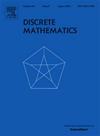Spectral extremal problems for non-bipartite graphs without odd cycles
IF 0.7
3区 数学
Q2 MATHEMATICS
引用次数: 0
Abstract
A well-known result of Mantel asserts that every n-vertex triangle-free graph G has at most edges. Moreover, Erdős proved that if G is further non-bipartite, then . Recently, Lin, Ning and Wu (2021) [35] established a spectral version by showing that if G is a triangle-free non-bipartite graph on n vertices, then , with equality if and only if , where is obtained from by subdividing an edge. In this paper, we investigate the maximum spectral radius of a non-bipartite graph without some short odd cycles. Let be the graph obtained by identifying a vertex of and a vertex of the smaller partite set of . We prove that for and , if G is an n-vertex -free non-bipartite graph, then , with equality if and only if . This result could be viewed as a spectral analogue of a min-degree result due to Yuan and Peng (2025) [54]. Moreover, our result extends a result of Guo, Lin and Zhao (2021) [20] as well as a recent result of Zhang and Zhao (2023) [59] since we can get rid of the condition that n is sufficiently large. The argument in our proof is quite different and makes use of the classical spectral stability method and the double-eigenvector technique. The main innovation lies in a more clever argument that guarantees a subgraph to be bipartite after removing few vertices, which may be of independent interest.
无奇环非二部图的谱极值问题
Mantel的一个著名结论断言,每个n顶点无三角形图G最多有⌊n2/4⌋边。更进一步,Erdős证明了若G是非二部的,则e(G)≤⌊(n−1)2/4⌋+1。最近,Lin, Ning和Wu(2021)[35]通过证明如果G是n个顶点上的无三角形非二部图,则λ(G)≤λ(S1(Tn−1,2)),且当且仅当G=S1(Tn−1,2)时相等,其中S1(Tn−1,2)是由Tn−1,2通过分割一条边得到的。本文研究了不含短奇环的非二部图的最大谱半径。设C2 r +1(Tn−2 r,2)是通过识别C2 r +1的一个顶点和较小的部分集n−2 r,2的一个顶点得到的图。证明了对于1≤r <;k且n≥187k,若G是n顶点{C3,…,C2, r−1,C2k+1}自由非二部图,则λ(G)≤λ(C2, r +1(Tn−2,2)),当且仅当G=C2, r +1(Tn−2,2)时相等。这个结果可以看作是Yuan和Peng(2025)[54]最小度结果的光谱模拟。此外,我们的结果扩展了Guo, Lin和Zhao (2021) b[20]的结果以及Zhang和Zhao (2023) b[59]最近的结果,因为我们可以摆脱n足够大的条件。在我们的证明中,我们使用了经典的谱稳定性方法和双特征向量技术。主要的创新在于一个更聪明的论点,即保证子图在移除几个顶点后是二部的,这些顶点可能是独立的兴趣点。
本文章由计算机程序翻译,如有差异,请以英文原文为准。
求助全文
约1分钟内获得全文
求助全文
来源期刊

Discrete Mathematics
数学-数学
CiteScore
1.50
自引率
12.50%
发文量
424
审稿时长
6 months
期刊介绍:
Discrete Mathematics provides a common forum for significant research in many areas of discrete mathematics and combinatorics. Among the fields covered by Discrete Mathematics are graph and hypergraph theory, enumeration, coding theory, block designs, the combinatorics of partially ordered sets, extremal set theory, matroid theory, algebraic combinatorics, discrete geometry, matrices, and discrete probability theory.
Items in the journal include research articles (Contributions or Notes, depending on length) and survey/expository articles (Perspectives). Efforts are made to process the submission of Notes (short articles) quickly. The Perspectives section features expository articles accessible to a broad audience that cast new light or present unifying points of view on well-known or insufficiently-known topics.
 求助内容:
求助内容: 应助结果提醒方式:
应助结果提醒方式:


